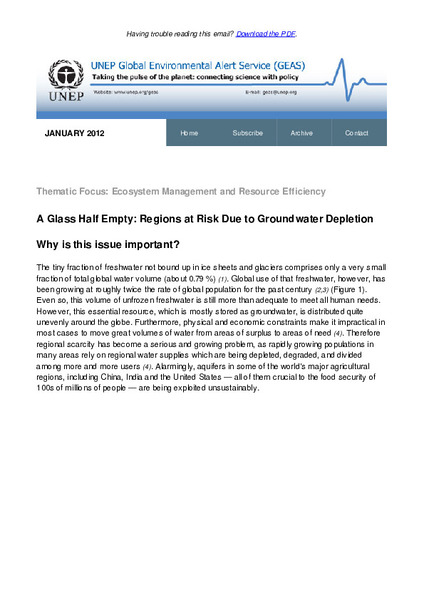A Glass Half Empty: Regions at Risk Due to Groundwater Depletion - UNEP Global Environmental Alert Service (GEAS) January 2012

Date
2012-01Author
United Nations Environment Programme
Citation Tool
Bibliographic Managers
RT Generic T1 A Glass Half Empty: Regions at Risk Due to Groundwater Depletion - UNEP Global Environmental Alert Service (GEAS) January 2012 A1 United Nations Environment Programme YR 2012-01 LK https://wedocs.unep.org/20.500.11822/40890 PB AB TY - GEN T1 - A Glass Half Empty: Regions at Risk Due to Groundwater Depletion - UNEP Global Environmental Alert Service (GEAS) January 2012 AU - United Nations Environment Programme Y1 - 2012-01 UR - https://wedocs.unep.org/20.500.11822/40890 PB - AB - @misc{20.500.11822_40890 author = {United Nations Environment Programme}, title = {A Glass Half Empty: Regions at Risk Due to Groundwater Depletion - UNEP Global Environmental Alert Service (GEAS) January 2012}, year = {2012-01}, abstract = {}, url = {https://wedocs.unep.org/20.500.11822/40890} } @misc{20.500.11822_40890 author = {United Nations Environment Programme}, title = {A Glass Half Empty: Regions at Risk Due to Groundwater Depletion - UNEP Global Environmental Alert Service (GEAS) January 2012}, year = {2012-01}, abstract = {}, url = {https://wedocs.unep.org/20.500.11822/40890} } TY - GEN T1 - A Glass Half Empty: Regions at Risk Due to Groundwater Depletion - UNEP Global Environmental Alert Service (GEAS) January 2012 AU - United Nations Environment Programme UR - https://wedocs.unep.org/20.500.11822/40890 PB - AB -View/Open
Item Statistics
Display item statisticsMetadata
Show full item recordDescription
The tiny fraction of freshwater not bound up in ice sheets and glaciers comprises only a very small fraction of total global water volume (about 0.79 %) (1). Global use of that freshwater, however, has been growing at roughly twice the rate of global population for the past century (2,3) (Figure 1). Even so, this volume of unfrozen freshwater is still more than adequate to meet all human needs. However, this essential resource, which is mostly stored as groundwater, is distributed quite unevenly around the globe. Furthermore, physical and economic constraints make it impractical in most cases to move great volumes of water from areas of surplus to areas of need (4). Therefore regional scarcity has become a serious and growing problem, as rapidly growing populations in many areas rely on regional water supplies which are being depleted, degraded, and divided among more and more users (4). Alarmingly, aquifers in some of the world's major agricultural regions, including China, India and the United States all of them crucial to the food security of 100s of millions of people are being exploited unsustainably.
Collections
Document Viewer
To read more, scroll down below.

